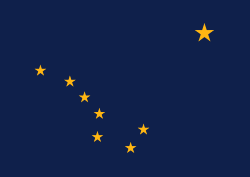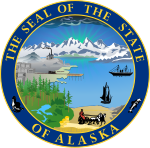Alaska
Alaska (/əˈlæskə/ (![]() listen)), officially the State of Alaska, is a state in the United States. It is in the northwest corner of North America.
listen)), officially the State of Alaska, is a state in the United States. It is in the northwest corner of North America.
Alaska
| |
|---|---|
| State of Alaska | |
| Nickname: The Last Frontier | |
| Motto: North to the Future | |
| Anthem: Alaska's Flag | |
 Map of the United States with Alaska highlighted | |
| Country | United States |
| Before statehood | Territory of Alaska |
| Admitted to the Union | January 3, 1959 (49th) |
| Capital | Juneau |
| Largest city | Anchorage |
| Largest metro and urban areas | Anchorage |
| Government | |
| • Governor | Mike Dunleavy (R) |
| • Lieutenant Governor | Nancy Dahlstrom (R) |
| Legislature | Alaska Legislature |
| • Upper house | Senate |
| • Lower house | House of Representatives |
| Judiciary | Alaska Supreme Court |
| U.S. senators |
|
| U.S. House delegation | Mary Peltola (D) (list) |
| Area | |
| • Total | 665,384[1] sq mi (1,723,337 km2) |
| • Land | 571,951[2] sq mi (1,481,346 km2) |
| • Water | 91,316 sq mi (236,507 km2) 13.77% |
| • Rank | 1st |
| Dimensions | |
| • Length | 1,420 mi (2,285 km) |
| • Width | 2,261 mi (3,639 km) |
| Elevation | 1,900 ft (580 m) |
| Highest elevation | 20,310 ft (6,190.5 m) |
| Lowest elevation | 0 ft (0 m) |
| Population (2020[5]) | |
| • Total | 733,391 |
| • Rank | 48th |
| • Density | 1.10/sq mi (0.42/km2) |
| • Rank | 50th |
| • Median household income | $77,800[4] |
| • Income rank | 12th |
| Demonym | Alaskan |
| Language | |
| • Official languages | Ahtna, Alutiiq, Dena'ina, Deg Xinag, English, Eyak, Gwich'in, Haida, Hän, Holikachuk, Inupiaq, Koyukon, Lower Tanana, St. Lawrence Island Yupik, Tanacross, Tlingit, Tsimshian, Unangax̂, Upper Kuskokwim, Upper Tanana, Yup'ik |
| • Spoken language |
|
| Time zones | |
| east of 169°30' | UTC−09:00 (Alaska) |
| • Summer (DST) | UTC−08:00 (ADT) |
| west of 169°30' | UTC−10:00 (Hawaii-Aleutian) |
| • Summer (DST) | UTC−09:00 (HADT) |
| USPS abbreviation | AK |
| ISO 3166 code | US-AK |
| Latitude | 51°20'N to 71°50'N |
| Longitude | 130°W to 172°E |
| Website | alaska |
| Alaska state symbols | |
|---|---|
 | |
 | |
| Living insignia | |
| Bird | Willow ptarmigan |
| Dog breed | Alaskan Malamute |
| Fish | King salmon |
| Flower | Forget-me-not |
| Insect | Four-spot skimmer dragonfly |
| Mammal |
|
| Tree | Sitka Spruce |
| Inanimate insignia | |
| Fossil | Woolly Mammoth |
| Gemstone | Jade |
| Mineral | Gold |
| Other | Dog mushing (state sport) |
| State route marker | |
 | |
| State quarter | |
 Released in 2008 | |
| Lists of United States state symbols | |
Alaska does not touch other US states. It has borders with Canada, the Arctic Ocean, the Pacific Ocean, the Bering Sea, and the Bering Strait. The United States bought Alaska from Russia on March 30, 1867. This was called the Alaska Purchase. This prevented Russia from having land on continental North America. Alaska cost $7.2 million. Today, that would be $120 million. The price was about $0.02 per acre ($4.74/km2).
Alaska is the biggest state in the United States.[6] It is the 3rd least populated state. It has the lowest population density of all the states. About half of the population of Alaska lives in the Anchorage metropolitan area. As of the 2020 census, 731,158 people live in Alaska.[7]
Alaska became an organized (or incorporated) territory on May 11, 1912. It became the 49th state on January 3, 1959.[8]
The name Alaska comes from the Aleut word alaxsaq. This means "the mainland" or "the object towards which the action of the sea is directed."[9] The land is also called Alyeska, which is another Aleut word that means "the great land." The Russian name was Аляска.
Alaska mainly exports seafood, primarily salmon, cod, Pollock and crab. The oil and gas industry is very important in the Alaskan economy. More than 80% of the state's revenues is from petroleum extraction.
"Seward's Folly"
changeWilliam H. Seward, the 24th United States Secretary of State, negotiated the Alaska Purchase with the Russians in 1867 for $7.2 million. It was called Seward's Folly at the time.
Russia's ruler then was Tsar Alexander II, the Emperor of the Russian Empire, King of Poland and Grand Duke of Finland. He also planned the sale.[10]
The purchase was made on March 30, 1867. Six months later the commissioners arrived in Sitka and the formal transfer was arranged; the formal flag-raising took place at Fort Sitka on October 18, 1867. In the ceremony 250 uniformed U.S. soldiers marched to the governor's house at "Castle Hill", where the Russian troops lowered the Russian flag and the U.S. flag was raised. This event is celebrated as Alaska Day, a legal holiday on October 18.
Geography
changeThe capital city is Juneau, but the biggest city is Anchorage. Alaska is the biggest state in the United States, but it has one of the smallest populations. It is also the least densely populated: more than half of the population live in the Anchorage Metropolitan Area. Alaska has almost 20% of all the land in the U.S., but only about 0.2% of the people. It is not connected to any other states by American land, but it is connected to the territories of Yukon and British Columbia in Canada.
Alaska has many glaciers, some of which can be seen from passing cruise ships. Some are coastal, and others are not by the ocean. It is a popular tourist destination, as there is a very rich culture along with beautiful scenery. There are wild animals in Alaska. Some of them are the brown bear, the moose, and the wolf.
There are some important industries in Alaska, like oil, fishing, mining, transportation, tourism, and forestry. Oil is the biggest industry in Alaska. Most of the oil is very far north in the Alaskan arctic. A very long pipeline starts at the northern coast of Alaska and runs to the southern coast. It is over 800 miles (1,300 km) long. There were many gold rushes in Alaska. The Ted Stevens Anchorage International Airport (ANC) is ranked as the world's fourth busiest cargo airport.
Tongass National Forest, the largest national forest in the United States, is in Southeast Alaska. The state capital Juneau, and the former capital Sitka, are in Southeast Alaska.[11]
Aleutian Islands
changeMany active volcanoes are found in the Aleutians in Alaska. They are a chain of 14 large volcanic islands and 55 smaller islands. Most of the Aleutian Islands belong to the U.S. state of Alaska, but some belong to Russia.[12]
One of the world's largest tides occur in Turnagain Arm, just south of Anchorage, where the differences in the tides can be more than 35 feet (10.7 m).[13]
It is widely believed that the region served as the entry point for the initial settlement of North America by way of the Bering land bridge.
State symbols
change- State Motto: North to the Future
- Nicknames: "The Last Frontier" or "Land of the Midnight Sun" or "Seward's Icebox"
- State bird: Willow Ptarmigan, decided by the Territorial Legislature in 1955. It is a small (15–17 inches) Arctic grouse that lives among willows and on open tundra and muskeg. Feathers are brown in summer, changing to white in winter. The Willow Ptarmigan is common in much of Alaska.
- State dog: Alaskan Malamute, since 2010.[14]
- State fish: King Salmon, since 1962.
- State flower: wild/native Forget-me-not, decided by the Territorial Legislature in 1917.[15] It is a perennial that is found throughout Alaska, from Hyder to the Arctic Coast, and west to the Aleutians.
- State fossil: Woolly mammoth, since 1986.
- State gem: Jade, since 1968.
- State insect: Four-spot skimmer dragonfly, since 1995.
- State land mammal: Moose, since 1998.
- State marine mammal: Bowhead whale, since 1983.
- State mineral: Gold, since 1968.
- State song: "Alaska's Flag"
- State sport: Dog Mushing, since 1972.
- State tree: Sitka spruce, since 1962.
References
change- ↑ "State Area Measurements and Internal Point Coordinates". Census.gov. Retrieved September 1, 2023.
- ↑ "Geography of Alaska, Alaska Kids' Corner, State of Alaska".
- ↑ "Elevations and Distances in the United States". United States Geological Survey. 2001. Archived from the original on October 15, 2011. Retrieved October 21, 2011.
- ↑ "US Census Bureau QuickFacts". Retrieved April 30, 2022.
- ↑ "2020 Population and Housing State Data". census.gov. United States Census Bureau. Archived from the original on November 18, 2023. Retrieved November 18, 2023.
- ↑ The State of Alaska
- ↑ "Annual Estimates of the Resident Population for the United States, Regions, States, and Puerto Rico: April 1, 2010 to July 1, 2011". 2011 Population Estimates. United States Census Bureau, Population Division. December 2011. Archived from the original (CSV) on January 6, 2012. Retrieved 2011-12-21.
- ↑ Video: 49th Star. Alaska Statehood, New Flag, Official, 1959/01/05 (1959). Universal Newsreel. 1959. Retrieved 2012-02-20.
- ↑ Ransom, J. Ellis. 1940. Derivation of the Word "Alaska". American Anthropologist n.s., 42: pp. 550–551
- ↑ The man who $old Alaska Archived December 1, 2020, at the Wayback Machine – Anchorage Daily News
- ↑ "SitNews - 1927: When Ketchikan was the Largest City in Alaska By DAVE KIFFER". www.sitnews.us. Retrieved 2021-05-04.
- ↑ The Editors of Encyclopædia Britannica (18 December 2015). "Aleutian Islands".
- ↑ Porco, Peter (June 23, 2003). "Long said to be second to Fundy, city tides aren't even close". Anchorage Daily News.
- ↑ "It's official: Malamute now Alaska's state dog – KTUU.com | Alaska's news and information source |". KTUU.com. 2010-05-12. Retrieved 2010-06-02.[dead link]
- ↑ "Alaska Conservation Foundation – State Symbols". Archived from the original on 2009-02-25.

